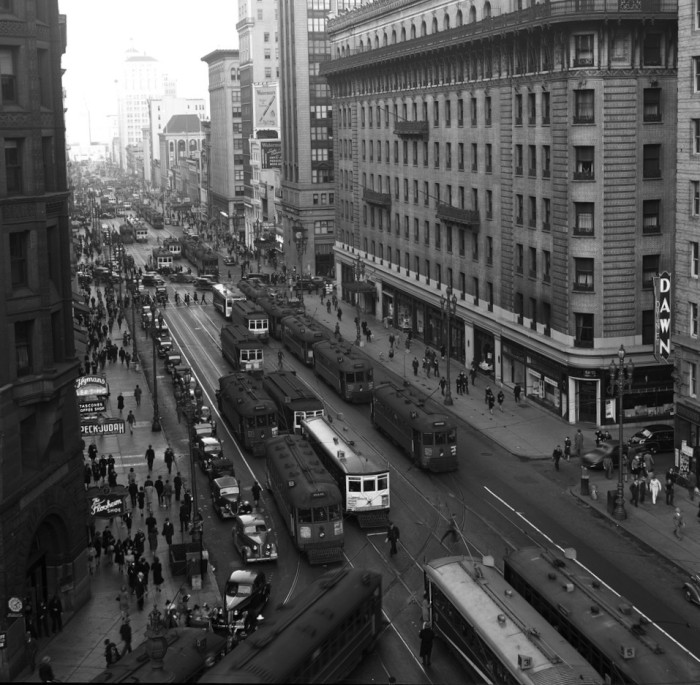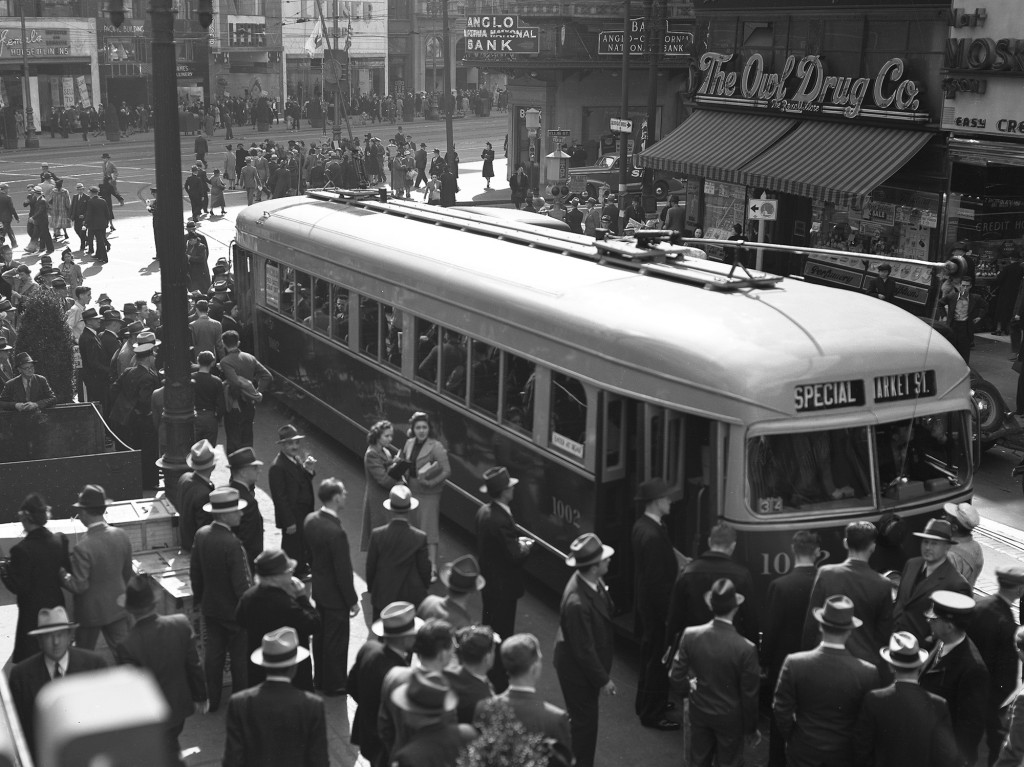
In this 1940 shot from the SFMTA Archives, you can see automobiles jousting with streetcars for space on Market Street. This car-car clash was a big reason streetcars almost died out in the U.S.
One of the central beliefs in the heart of many U.S. railfans is that the golden age of streetcars was cruelly crushed by a 1940’s conspiracy led by General Motors and petroleum and tire companies in an illegal scheme to sell buses. The agent was a company called National City Lines.
There’s no question that National City Lines bought up dozens of privately owned transit operations around the U.S., including the Key System here in the Bay Area, and largely succeeded in converting streetcars to buses. But an excellent article in Vox by Joseph Stromberg argues persuasively that the conspirators were vultures picking at the carcass of a mode of transit that was already dead or dying in most American cities (San Francisco being, as in many things, something of an exception).
(Note to those already blowing steam out of their ears and raring to rant: no comments will be accepted on this post unless you can demonstrate in your remarks that you actually read the linked article.)
We hear the mantra of evil GM et al repeated all the time. It’s really a religion among some. But as Stromberg points out,
“The real reasons for the streetcar’s demise are much less nefarious than a GM-driven conspiracy — they include gridlock and city rules that kept fares artificially low — but they’re fascinating in their own right, and if you’re a transit fan, they’re even more frustrating.”
Every early “public” transit system was actually privately owned, and operated to make a profit. San Francisco’s experience was typical. Many pioneering rail transit lines (initially pulled by horses, then cables, then powered by overhead wires) were started by entrepreneurs. Soon, though, they were consolidated by bigger players — in San Francisco’s case, initially by the owners of the mighty Southern Pacific Railroad.
These rail transit lines operated under franchises from the cities that hosted them. In getting the rights to put tracks into public streets and a monopoly on operating routes, they agreed to maintain the street areas around the tracks and have fares regulated. In practicality, city after city forced private operators to keep the fare at five cents for decades, regardless of inflation.
Stromberg’s analysis doesn’t mention it, but the unchanging nickel fare forced private operators to keep cutting maintenance, which meant the streetcars, track, and overhead got increasingly decrepit. Many streetcar companies went bankrupt well before National City Lines came on the scene. Others got a boost in revenue during World War II when rationing forced automobile drivers back to transit, but this only prolonged those streetcars’ life, rather than curing the underlying ills.
Oh, those automobiles. What most conspiracy theorists choose to ignore is that the rise of the middle class and the power of mass production made automobiles affordable to more families every year. Many began to choose their cars instead of streetcars for many trips, eroding transit company revenues and increasing congestion on the streets the streetcars used. Later, many moved to new suburbs beyond the streetcar’s reach and drove their cars to work, again dueling with streetcars for street space. (We document this in our current exhibit, “Cars vs. Cars”, at our San Francisco Railway Museum.
Stromberg also gives too little attention to the real issue of labor costs. Most cities had increasingly powerful transit unions, which resisted reducing streetcar crews from two operators to one. This limited the spread of the comfortable, modern PCC streetcar, which industry leaders designed in the 1930s with the intent that it would be a single operator car. Transit companies that couldn’t win government approval to reduce crew size had no incentive to buy PCCs. Indeed, our namesake, Muni’s private competitor Market Street Railway Company won the right to run single-operator streetcars in the 1930s and drew up plans for PCC-line streamliners, but had the courts reverse that right and abandoned their streamliner dreams. (Muni PCC No. 1011 is painted in tribute to what might have been, if…)

Muni bought five PCC-like streetcars in 1939, but it was all they could afford, and they had to use two-operator crews to run them. SFMTA Archives.
Even America’s first urban transit system that was government-owned — Muni — felt the mix of economic pressures Stromberg describes. After acquiring the assets of the old Market Street Railway in 1944, Muni proceeded to do just what National City Lines did: convert most of its streetcar lines to buses, as quickly as they could. Equipment and track was worn out, increased automobile traffic was slowing streetcar service, and voters wouldn’t approve single-operator streetcars.
This isn’t news. We wrote about this at length in our member newsletter, Inside Track, in 2002 and later, posted the piece here, so no need to plow all that ground again. But because the over-simplified conspiracy trope keeps popping up, we think it’s important to remind people that it took more than a few corporations to almost kill the streetcar.
Speaking of reminders, we depend on YOU to help us keep today’s historic streetcar and cable car operations alive and vibrant through our advocacy and support programs. Please consider joining or contributing to Market Street Railway. Thanks.
I read that article a few days ago, And it does indeed leave out the “two man car” ordinances. Even Los Angeles had a brief period of “two man” requirements around 1939, and Chicago had PCCs with hand controls to keep the motorman busy enough to require a conductor. And the LARy “Sowbelly” center entrance car by its configuration would have require extensive modifications for what the British call “Driver Only Operation”. Regarding LARy being bought out by NCL’s LA Transit Lines (Muni 1080 comes to mind): Many years ago, while searching for traces of a PE line in San Marino, I encountered a retired manager from the Huntington Estate. He told me that the Estate was a willing seller when NCL made them an offer. They had adopted a policy of divesting “operating properties” and holding “gilt-edged securities”. Or as he put it in plain English: “If it eats or has to be painted, you don’t want your money in it.”
This is an interesting but incomplete article because, as others have mentioned it doesn’t get into the labor issues. I was also hoping that the author would cite the work of John Diers who also tackled this issue in January 2006 article in Trains magazine and the epilogue in “Twin Cities by Trolley,” a book he co-wrote. Diers explains who was responsible for the demise of the streetcars: “everyone who bought an automobile between 1920 and 1950…along with US automakers, the banks and financial institutions that profited from auto loans, and the state, local and federal governments that paved highways.”
There were numerous economic, political and societal causes for the trend away from streetcars, and non-NCL systems around the world were also affected. This subject deserves book-length treatment.
The NCL conspiracy theory also ignores how world-wide the process of abandoning tramways was from the 1920s; if anything, the US was a little behind that game, at least as far as the English-speaking world was concerned.
Britain, Canada and Australia had shut down all but one of their street tramway systems by the early 1960s; New Zealand (where I live) saw off its last regular street tram in 1964 (there is now a heritage operation, opened in 1995, in Christchurch). Elsewhere the pattern was similar – even in Germany and Switzerland many small systems and lines in the big cities closed in the period. Most such systems were municipally owned, beyond the direct control of private-sector conspiracies.
The NCL simply exploited a commercial opportunity in a well-established trend – the basis of the market economy.
According to The People’s Railway by Anthony Perles, the first consultant to propose conversion to motor coach was Sydney Bingham, New York City Transportation Commissioner on loan to the City by New York Mayor William O’Dwyer. However, the person to carry out the changes was Marmion D. Mills, the first president of National City Lines, regional sales manager for General Motors Yellow Coach subsidiary, now consultant for the City. He led the conversion of the former Market St. Ry. lines and lines and lines D, E, F and H during 1948-49. (Lines B and C were not converted until 1956. Line B became Line 38, while daytime service on the 2nd Ave. section of the C Line simply came to an end. Owl service on 2nd, California and 32nd continued until 1979 on the 38 Line.)
Brent Efford’s statement sums it up nicely: “[National City Lines] simply exploited a commercial opportunity in a well-established trend.” In other words, streetcar lines were going to be replaced anyway, because of the rise of the automobile, worn out infrastructure, inadequate fare revenues, and several other factors, so why not take advantage of the situation to sell their products?
It was a conspiracy — GM, Firestone Tire, and Standard Oil were actually convicted of the conspiracy — but yes, it was in the context of a general cultural willingness to kill the streetcars. Which is why the judge fined the corporations a pittance after he found them guilty — he had to find them guilty by law, but the judge and the general public didn’t think they’d done anything wrong, even if they’d done something illegal.
The public at the time treated the conspiracy to rip out the streetcars the way we think of, say, smoking marijuana today. Sure, illegal, but people didn’t think it should be illegal.